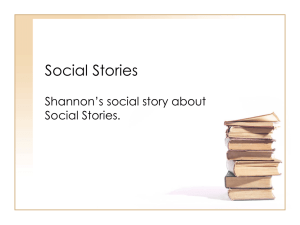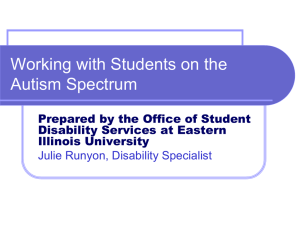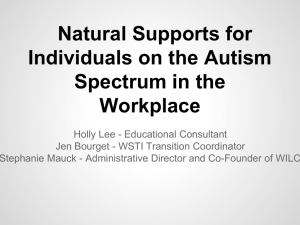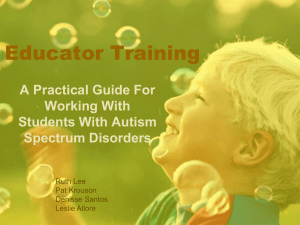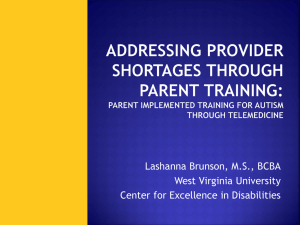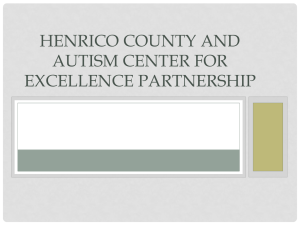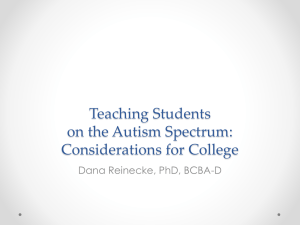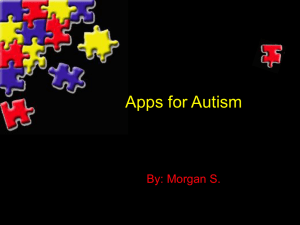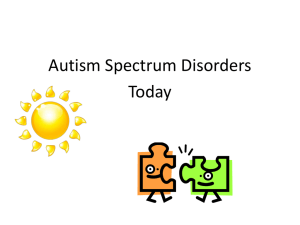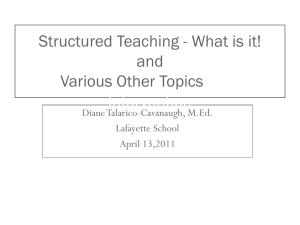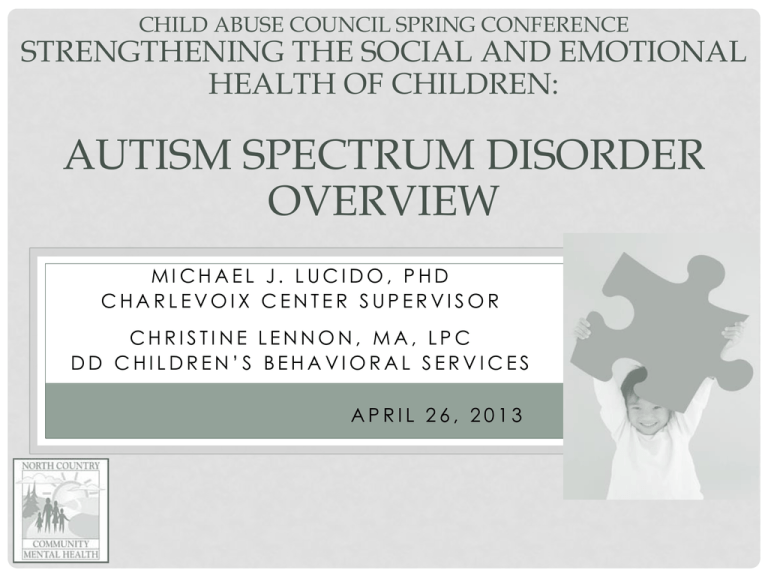
CHILD ABUSE COUNCIL SPRING CONFERENCE
STRENGTHENING THE SOCIAL AND EMOTIONAL
HEALTH OF CHILDREN:
AUTISM SPECTRUM DISORDER
OVERVIEW
MICHAEL J. LUCIDO, PHD
CHARLEVOIX CENTER SUPERVISOR
CHRISTINE LENNON, MA, LPC
DD CHILDREN’S BEHAVIORAL SERVICES
APRIL 26, 2013
Raise your hand if
you personally know
someone impacted
by autism or
Asperger’s.
PREVALENCE RATE
TAKING A LOOK AT AUTISM
STEPHEN WILTSHIRE’S STORY
Following 20 minute ride, he
drew an 18 ft long drawing of
New York city in exact detail
PERVASIVE DEVELOPMENTAL DISORDERS
Autistic Disorder:
• Social impairment.
• Communication impairment.
• Restricted repetitive/stereotyped behaviors, interests, or activities.
Asperger’s disorder:
• Higher functioning form of ASD.
• Normal language with single words by 2-phrases by 3.
Rett’s Disorder:
• Exclusively female genetic developmental disorder-progressive delays
throughout lifespan
• Severe “apraxia”-inability to execute purposeful movements despite physical
capability.
Childhood Disintegrative:
• “Heller’s Syndrome”- normal development from 2-10 years of age but then
severe decline.
• Causes by lipid storage diseases, subacute sclerosing panencephalitis,
tuberous sclerosis.
PDD Not otherwise specified:
• Do not meet full criteria but have symptoms similar to the diagnoses above.
DSM-V AUTISM SPECTRUM DISORDER (ASD)
DSM-V (2010) revised label & criteria:
• Autism Spectrum Disorder under one label
• Rett’s disorder is considered separate of
ASD
• Reduced to two criterion
• Require multiple observations
• Provide qualifiers such as “with intellectual
disability” or “due to Fragile X syndrome”
Grandin wrote,
• “As a child I remember Mother
asking me time and again,
‘Temple, are you listening to me?
Look at me.’ Sometimes I wanted
to, but I couldn’t...”
AUTISM SPECTRUM DISORDER CRITERION
Repetitive and
Obsessive Behaviors
Socialization and
Communication
• Poor eye contact
• Flat expressions
• No peer relationships
• Odd speech
ASD
• Echolalia
• Misinterpret emotion
• Conversation issues
• Rocking
• Hand wringing
• Twisting fingers
• Fixated interests
• Intense focus
• Set routines
• Preoccupied parts
• Sensory issues
BEHAVIORAL SIGNS AND SYMPTOMS
• Speech: monotone, rhythmic,
nasally/high pitched (dysarthric),
pedantic, repeating phrases (echolalic),
and other idiosyncratic speech patterns.
• Eye contact: no, limited, or inappropriate
eye contact- towards the ceiling, looking
at the body, avoiding face/eyes.
• Gross and fine motor coordination:
unable to balance on foot or tandem
walk, or poor writing (dysgraphia).
• Stereotyped behaviors: hand-wringing or
twisting, spinning in chair, complex whole
body movement, hand-flapping, pacing.
SENSORY DISTURBANCES
• Behavior “meltdowns” are often sensory related
• Grandin wrote,
• “But when I was in the world of people, I was
extremely sensitive to noises..The pain that racked
my head when the fog horn sounded was
excruciating”. (hyperacusis-sensitivity)
• “Spinning was another favorite activity. I’d sit on the
floor and twirl around. The self-stimulatory behavior
made me feel powerful, in control of things…I
realize that non-autistic children enjoy twirling
around in a swing, too. The difference is that autistic
child is obsessed with the act of spinning”.
UNDERSTANDING THE “BEHAVIORS”
• Common misnomers about
behaviors:
•
•
•
•
He can control his meltdowns!
She is being oppositional!
He just wants it his way!
He can stop biting himself!
• It is an underlying neurological
condition-first and foremost
• Most of the time is out of their
control
• They struggle to be “normal”
WHAT CAUSES AUTISM?
IS IT THE PARENTS?
• Kanner said autism is a result of “genuine
lack of maternal warmth”.
• Bruno Bettleheim said autism was caused
by maternal coldness.
• Finally by 1960s, Bernard Rimland said it
was a neurological disorder.
TEMPLE GRANDIN’S STORY
Graduated with a doctoral degree in
animal science, wrote many books on
autism and animal issues
A FEW THEORIES ON THE CAUSE OF ASD
• No single theory explains ASD
• Genetic and heredity
• Abnormal development
• Physical health issues
• Autoimmune problems
• Environmental toxins
HEREDITY & GENETIC ABNORMALITIES
• Monozygotic twins as high as 60-95% and siblings
are 45-60 times greater to develop autism
• First degree relatives might have psychiatric
issues like depression, OCD, anxiety disorders, etc
• X Chromosome as a factor?
• Fragile , Turner’s syndrome, Klinefelter, Rett, Prader-Willi,
Timothy, Phenylketonuria, and Angelman syndromes.
• Reason for higher rates in males? (XY vs. XX in females)
DEVELOPMENTAL GROWTH
• 20-30% have seizures, up to 72% abnormal EEG
• 75% smaller head circumferences at birth, but
rapid growth by first year in the 85th percentile
• 100-200g heavier brain weight in autism
• Deficits in Emotion centers: amygdala,
prefrontal cortex, temporal lobes, & thalamus
• Dysregulated neurochemicals like serotonin,
dopamine, melatonin, and oxytocin
NEUROLOGICAL PATHWAYS FOR ASD
GASTROINTESTINAL PROBLEMS
• Gastrointestinal problems as high as 84%
• Constipation, problems going to the bathroom, etc
• These health issues impact moods, behaviors, appetite
• Interaction between the gut and the brain is
important to understanding ASD-serotonin?
• Food allergies is strongest link to GI issues
• Food allergies have been attributed to conditions like celiac
disease, which lead to the abdominal problems
AUTOIMMUNE RESPONSE
• Lowered immune response
• High opioid activity
• High pain thresholds- high endorphin levels
• Endocrine system related to thyroid
• Concerns regarding hypothyroidism or low
thyroid will impact brain development
• Considered an iodine deficiency in prenatal
and neonatal development
ENVIRONMENTAL TOXINS
• Industrialization increased exposure to neurotoxins
• Heavy metals like mercury, lead, or cadmium
• Pesticides such as cyanide.
• Clothing, food, building materials, personal care
• New Jersey has highest rates for autism & asthmahas highest pollution levels in the nation
• Wakefield: vaccines link to autism retracted
• 18 controlled epidemiological studies found no link
• No one factor accounts for autism
DIAGNOSING AUTISM
EVIDENCED BASED PRACTICES
WHAT IS EVIDENCED-BASED
PRACTICE?
American Psychological Association (2006):
• EBP: “integration of the best available
research with clinical expertise in the context
of patient characteristics, culture, and
preferences”.
• EBP is comprehensive with assessment, case
formulation, therapeutic relationship, and
specific decision-making process integrating
research and intervention together.
A NEED FOR COMPREHENSIVE CARE
EBP
services:
• Psychological evaluation
• Behavioral, OT, and Speech Assessments
• Psychiatric evaluation and medications
• Dietary modifications and supplements
• Behavioral interventions
• Individual/group therapy
• Parent Training
• Case management
• Employment assistance
• Occupational therapy
• Speech therapy
• And many more!!!
HISTORY OF LACK OF FUNDING FOR
SERVICES
Costs are $35 billion per year nationwide
Average costs:$29,000-$43,000 per year
History of disparity of Federal funding
President proposed $1 billion increase of
annual federal spending on autism
Michigan Department of Community
Health expanded autism services
MDCH AUTISM SERVICES EXPANSION
• Created the 1915i State Plan
Amendment and 1951b Mental Health
Specialty Services and Support Waiver
• Started April 1, 2013
• Consist of early identification-average
age of child being diagnosed with
autism is age 8 in Michigan.
• Targeted18 months through age 5
ASD SCREENING AND DIAGNOSIS
• Screening forms by parent and referred by
pediatrician
• Modified Checklist for Autism in Toddlers (16-30 mo.)
• Social Communication Questionnaire (ages 2 )
• Referred to Access Center for a more in depth
diagnostic evaluation.
• Evaluation will consist of an in depth clinical
interview, assessment, and other tests for
behaviors, ability, language, etc as needed.
• Diagnosis must be confirmed by a fully licensed
psychologist or physician/psychiatrist.
QUESTIONNAIRES ASSESSMENT
• Autism Diagnostic Interview-“Gold standard” (ADI)
• Autism Spectrum Rating Scales (ASRS)
• Autism Treatment Evaluation Checklist (ATEC)
• Modified Checklist for Autism in Toddlers (MCHAT)
• Asperger Syndrome Diagnostic Scale (ASDS)
• Gilliam Autism Rating Scale: 2nd Edition (GARS2)
• Childhood Autism Rating Scale (CARS)
• Social Communication Questionnaire (SCQ)
• Social Responsiveness Scale (SRS)
PSYCHOLOGICAL TESTING
Autism Diagnostic
Observation Schedule
(ADOS)
“Gold standard”
for assessing
behaviors of ASD
New versions of IQ
testing
Profiles for
individuals with
autism.
LOOKING BEYOND IQ
• University of Montreal found intelligence tests
(WISC, WAIS) in ASD over-diagnosing ID
• None of the children scored in the high average
range and a 1/3 scored in the ID range
• Nonverbal IQ test, a 1/3 scored in the high
average range, and only 5% scored as ID
• Newer intelligence tests have profiles for ASD to
explain such conflicting results
KIM PEEK’S STORY
•
•
•
•
Inspired by movie Rain Man
Read two pages at once
Memorized 12,000 books
Low average IQ
NEUROPSYCHOLOGICAL TESTING
Neuropsychological testing:
• Stroop
• Continuous Performance
• Trail Making
• Shifting Attention
• Symbol-digit coding
• Finger Tapping
• Verbal/Visual memory
Executive functioning deficits in ASD:
• Cognitive flexibility/switching
• Organization, planning
• Visual-working memory
• Verbal fluency
• Complex attention
READING THE MIND’S EYE TEST
• Visual-perceptual
processing
• Problems with facial
recognition, and socialemotional processing.
• Social cognitive test for
empathy or “Theory of
Mind”.
• Best way to evaluate
social issues is through
observations.
OCCUPATIONAL/SPEECH ASSESSMENT
• Special education ASD
evaluations include
speech and occupational
evaluations when
identifying ASD.
• CMH provides
contractual support for OT
and Speech when
physician has ordered
interventions for ASD in
the home.
NEED FOR MEDICAL EVALUATIONS
• Gastroenterologist- problems with intestines and
stomach including issues like constipation
• Neurologist- brain imaging like CT scans and brain
function with EEG
• Immunologist/allergist- identify potential
environmental allergies influencing behaviors
• Dietitian- identify health habits
• Psychiatrist- medications for behavior and mood
EVIDENCED-BASED PRACTICES FOR ASD
AUTISM INTERVENTIONS
OPTIMIZING LIFE PURSUITS IN ASD
Grandin wrote,
“I think the same principle
applies to autistic childrenwork with them instead of
against them. Discover their
hidden talents and develop
them”.
PERSON-CENTERED
• Assist parents and individuals with ASD:
• Understanding procedures, aid in
documents, ease transition in services,
respect, be flexible.
• PC seeks collaboration with natural
supports and community.
• Empathy, unconditional positive regard:
• Individuals with autism are often on a one
way street-walk with them for a while!
MDCH ASD BEHAVIORAL SERVICES
• Provided to age 18 months-5 y/o
• Applied Behavior Analysis (ABA)
• Science of the principles of behavior
• Two levels of service intensity for ABA
• Early Intensive Behavioral Intervention (EIBI)
• Children with a diagnosis of autistic disorder
• Average of 10-20 hours per week
• Applied Behavioral Intervention (ABI)
• Children with a diagnosis of Aspergers, PDD, etc
• Average of 5-15 hours per week
HOW SERVICES WILL BE CONDUCTED
• Structured applied behavior analysis
program that relies upon discrete trial
training (DTT) methods and incidental
teaching opportunities
• Administered in a child’s home or a clinic
setting.
DISCRETE TRIAL TRAINING
• Comprehensive structured behavioral
intervention or discrete trial training
(Lovaas, 1987)
• Operant conditioning (Skinner):
rewarding specific behaviors to
increase the likelihood of the behavior
occurring again
• Learning environment is structured
• Target behaviors are broken down into
discrete subskills
• Initiated and selected by adult
• Child’s response is prompted
• Reinforcers are unrelated to the target
response (e.g. toy)
• Rewards for correct response or
successive approximations
DIR FLOOR-TIME
• Developmental, Individual Difference,
Relationship-Based (DIR) Floortime Model
(Greenspan, 2000)
• Infants to preschoolers improve socialemotional cognition
• Motive, planning, and sequencing
• http://www.youtube.com/watch?v=jrXGh9bT0Sw
PIVOTAL RESPONSE TRAINING
• Pivotal response training: teaching core or pivotal
skills makes it easier for children with autism to
learn basics (Koegel et al., 2001)
• Increasing motivation to engage in social
communication
•
•
•
•
Motivation
Self-regulate behaviors
Initiate social interactions
Response to multiple social cues
COGNITIVE-BEHAVIORAL THERAPY
•Social skills training
•Anger management
•Rethinking perspective
•Regulate emotions
•Social skills training
•Social Autopsies
•Social Stories
ASD PSYCHOPHARMACOLOGY I
ASD 2nd Generation Neuroleptics:
• FDA (2006) approved
risperidone as the first
medication to treat irritability
and aggression in children
and adolescents with autism.
• Other medications like
aripiprazole (second
generation antipsychotics)
are being approved for
autism.
• Improve both dopamine and
serotonin regulation.
• Decrease aggression, selfinjuries, irritability, and
improve mood stability.
ASD Antidepressants:
• Research for 20 years including
clomipramine, desipramine,
fluoxetine, citalopram,
sertraline, and venlafaxine.
• improve stereotypic and
obsessive behaviors.
• Medscape (2010) SSRIs are not
recommended for just ASD
because of limited research.
• Sertraline, fluoxetine, and
fluvoxomine are approved for
OCD, and fluoxetine and
escitalopram approved for
depression.
• Symptoms of anxiety and
depression that are comorbid
with ASD.
ASD PSYCHOPHARMACOLOGY II
Anxiolytic:
Anticonvulsant:
1st generation
neuroleptic:
Neurostimulant:
Antihypertensive:
• decrease hyperarousal, agitation,
improve dental visits
• decrease seizures and stabilize moods
• Decrease aggression
• improve attention, concentration, and
impulsivity
• improve sleep and attention and
decrease aggression
DIETARY AND VITAMINS
• Ketogenic diets (used in seizure disorders) and
gluten-casein free diets (used in schizophrenia)
• Melatonin for initiating sleep
• Fish Oil (EFA) improves cognition
• Vitamin D to improve mood, sleep, cognition
• Vitamin B6 and B12 to improve cognition
• Oxytocin improve social affect and social cues
• Recommendations come from physicians
• Dietitians may provide nutrition consultation
OCCUPATIONAL THERAPY
• OT provides critical interventions that might
offset need for medication or other therapy
• Assists in skills like in improving hand writing
• Sensory diets regulate the environment and
structure daily activities to prevent overload
• Schedules are very important in ordering the
day’s sensory input!
SPEECH THERAPY
• Speech therapy teaches
effective ways to communicate
in areas like pragmatics
• Improve speech production
such as voice modulation
• Picture Exchange
Communication System (PEC)
• PECS are helpful for improving
communication and schedule
• Easily recognizable
• Exchange the picture for a desired activity
or item
ABUSE IN CHILDREN WITH AUTISM
ABUSE IN CHILDREN WITH DD
• A child with any type of developmental disability
was 4xs more likely to be sexually abused than a
child without (Sullivan & Knutson, 2000).
• 50% of children with autism are nonverbal and
unable to participate in usual means for verbal
interviews that require reciprocal communication.
AT RISK
• Struggle with interpreting caution and picking
up deceptive emotions in facial affect
• Perpetrators may target children with
nonverbal autism because inability to disclose
• Issues with sequencing of events and
misinterpreting them
• 50% of offenders of individuals with
developmental disabilities had contact with
them through their disability services
FORENSIC INTERVIEWING
• Need to provide multiple interviews in order to
gain rapport and short sessions vs. long sessions
• “Referential communication” ability to know
what another person is asking and refer to
• Question: “Did John Doe touch you”
• Answer: “No” (answering for today, but abuse
happened in past).
• Children with autism struggle with responding to
questions appropriately or accurate information
SIGNS AND SYMPTOMS
• Often simply noticing
change of behaviors
is most important
• Increased selfstimulation
• Self-injurious behaviors
• More meltdowns
• New Behaviors not
present before
INTERVENTION
• Trauma focused therapies such as play
therapy or cognitive therapies if verbal
• Sex education and education regarding
appropriate and inappropriate touch
• Difference between public and private
behaviors
• Providing social stories as a means of
communication
JASON “J-MAC” MCELWAIN’S STORY
In his first-ever high school
game, he scored 20 points
and tied the school record
with six 3-pointers in 4
minutes
In a book on autism, a mother
describing her son and others with
autism said,
“From their deep sense and
connection to the universe and our
planet they feel what a leaf feels,
they can smell cold, they are truly in
the moment. These special beings can
teach us many things through their gifts
that they have to offer.”
ANY THOUGHTS OR QUESTIONS?
Thank you!!!

